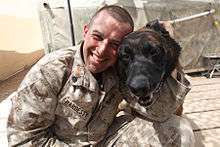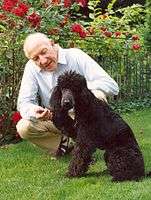Human–canine bond

Human–canine bonding is the mutually beneficial and dynamic relationship between humans and dogs that is studied by psychologists, anthropologists, and ethologists.[1]
Dogs are domesticated descendants of wolves and have a significant impact and role in human lives. In the United States, over 62% of people have a household pet and 37% of those pets are dogs.[2] In the United Kingdom for 2016 the overall amount of people with pets is 47% with 24% having dogs. [3]
The related topic of anthropomorphism deals with the ideas people have about what animals know. Anthrozoology is a new field of study addressing human-animal interactions.
History
The concept of the animal bonding was articulated as early as the late 1930s, when Konrad Lorenz and his friend and colleague Nikolaas Tinbergen worked with geese in order to study the instinctive behaviors of animals, leading them to rediscover the principle of imprinting. The same concept was recognised in Boris Levinson's books Pet-Oriented Child Psychotherapy (1969) and Pets and Human Development (1979), which had an immense influence on the establishment of the field of study. Levinson is known for accidentally discovering the benefits of assisted pet therapy. He found that withdrawn and uncommunicative children would interact positively whenever he brought his dog, Jingles, to their therapy sessions. His discovery was further reinforced by Sam and Elizabeth Corson at Ohio State University, who were among the first to research and evaluate pet-facilitated therapy.[4]
Only in the early 1980s was the term 'human–animal bond' officially coined by Leo K. Bustad, who delivered a summary lecture on the Human-Pet Relationship on October 28, 1983, at the International Symposium in Vienna. This symposium was held in honour of Konrad Lorenz, and during his lecture, Bustad praised him for his work on the human–animal bond and encouraged others to build on Lorenz's work on the subject.[5] Lorenz later adopted it in his research on imprinting in geese.[2]
Bustad and other pet therapy advocate formed the Delta Society, which was built on the earlier work of Levinson and Croson.[4] In the 1970s and 1980s, national and international conferences led to greater recognition of the human–animal bond. Since then, there has been widespread media coverage of animal-assisted activity and therapy programs and service dog training.[5]
Theories

There are 3 major theories concerning the human–canine bond, known as the biophilia hypothesis, the social support theory, and the self-object theory.
According to the social support theory, animals are a source of social support and companionship, which are necessary for well-being.[2][6] Support is seen for the social support theory in the influence of a pet on an empty-nester family. In this view, the animal is part of our community and is an important determinant for psychological well-being.
According to self psychology, an animal can be a "self-object" that gives a sense of cohesion, support, or sustenance to a person's sense of self. Self-psychology explains why some animals are so crucial to a person's sense of self and well-being.[7] In some cases, individuals have been known to feel stronger, more protected, and more powerful in the company of their companion animal. The animal itself creates a human's personality.
Benefits
.jpg)
According to the American Veterinary Medical Association, the human–canine bond is influenced by emotional, psychological, and physical interactions that are essential to the health and well-being of both people and dogs.
Animal-assisted therapy (AAT), service dogs, and animal-assisted activities demonstrate this human–canine bond and this interaction with an animal; in most cases a dog helps improve the quality of life.[8]
The AVMA officially recognizes that the human-animal bond exists, that it has existed for thousands of years, and that it has had a major impact on veterinary medicine.[9]
The human–canine bond also pertains to working dogs, such as modern police dogs and search and rescue dogs.
-
.jpg)
Girl with a dog
-

Man with Poodle
-

Cockapoos and child
-
Labrador retriever and young man
-

Dog with his owner
-
Man and his dog
See also
References
- ↑ Stanley Coren (2006). The intelligence of dogs: a guide to the thoughts, emotions, and inner lives or our canine companions. Free Press. ISBN 978-0-7432-8087-7. Retrieved 27 May 2011.
- 1 2 3 Nitkin, Patricia. "The Human-Animal Bond", B.C. Cancer Agency, University of British Columbia. Retrieved on 2011-06-19.
- ↑ Pet Food Manufacturers Association. (2016). Pet Population 2016. Available from: http://www.pfma.org.uk/pet-population-2016. [Accessed: 3/12/2016].
- 1 2 Catanzaro, T. E. (2003). Section introduction: Human-animal bond and primary prevention. American Behavioral Scientists, 47, 29-30. doi: 10.1177/0002764203255209
- 1 2 Hindes, L. M. (2003). Historical perspectives on the human-animal bond. American Behavioral Scientists, 47(1), 7-15. doi: 10.1177/0002764203255206
- ↑ Beck, Alan M. (2003) "Future Directions in Human-Animal Bond Research," American Behavioural Scientist, Vol. 47, No. 1, pp. 79-93.
- ↑ Brown, Sue-Ellen (2011) "Self Psychology and the Human-Animal Bond: An Overview," The Psychology of the Human-Animal Bond, part 2, pp. 137-149.
- ↑ Society, Delta. "Animal Assisted Activities (AAA)". Retrieved 30 March 2012.
- ↑ The human-animal bond, American Veterinary Medical Association (n.d.).
Further reading
| Wikiversity has learning materials about Human-animal bond |
- Jon Franklin (1 September 2009). The Wolf in the Parlor: The Eternal Connection Between Humans and Dogs. Macmillan. ISBN 978-0-8050-9077-2. Retrieved 28 May 2011.
- Child development: Endenburg, Nienke & vanLith, Hein A. (2010). "The influence of animals on the development of children" The Veterinary Journal.
- Daly, Beth & Morton, L. L. (2009). "Empathetic Differences in Adults as a Function of Childhood and Adult Pet Ownership and Pet Type" Anthrozoos, 22(4), p371-382.
- Health benefits: Gillum, Richard F. & Obisesan, Thomas O. (2010). "Living with Companion Animals, Physical Activity and Mortality in a U.S. National Cohort" Int. J. Environ. Res. Public Health, 7(6), 2452-2459.
- Animal-assisted therapy and Animal-assisted activities: Friesen, Lori. (2009). "Exploring Animal-Assisted Programs with Children in School and Therapeutic Contexts" Early childhood education journal, 37(4), p261-267.